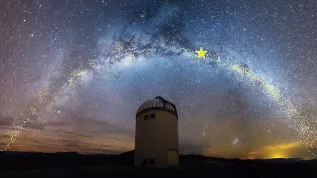
Poland\'s most advanced planetarium fitted with equipment worth approximately 13 million zlotys will open to the public in January. Equipped with a 14-foot dome screen, the facility was built in a revitalized historic building of the power station EC1 in Łódź.
"It is time to open for the opening of the most advanced Planetarium in Poland and in Europe. The first shows will be launched on January 8th. As promised, tickets for Łódź children - in organized groups - will cost only 5 zlotys. We tried to make it a publicly accessible facility, we want to as many young people as possible who are interested in map of the sky or space exploration to be able to learn using very good equipment" - emphasised President of Łódź Hanna Zdanowska at Wednesday\'s press conference.
The president added that the opening of the Planetarium is the next stage in giving new functions to revitalized objects of the former power station EC1; she reminded that for the next year the city planned to equip the Science and Technology Centre and the National Film Culture Centre, which will operate in this complex.
There are 110 seats under the 14-meter dome screen of the EC1 Planetarium in Łódź. Polish-American consortium responsible for its software and equipment provided an excellent image quality, eight times higher than HD - the resolution of more than 32 million pixels. The planetarium has six projectors controlled by 12 modern computers and a seamless spherical screen. According to the head of the Planetarium Tomasz Kisiel, this equipment allows for a total "immersion" in the image presented on the screen, and 5.1 surround sound enhances the impression.
"The program will include both afternoon shows for astronomy enthusiasts, and early morning screenings for schools to facilitate learning difficult science and natural science content. In all screenings there will be a live part to stimulate the interest of the participants and answer their questions, and allow to adapt the message to the perception capabilities of each group" - said Kisel.
The Planetarium EC1 Łódź will also host artistic and musical events, because the projection room has a unique acoustics. "Experiment on a sphere" is new medium closely related to cinema. We are also planning live music combined with projections on the dome. This will be an opportunity, for example, to show relations between music and space" - added the head of the Planetarium.
The facility is counting on the cooperation with teachers; its staff wants to help prepare the presentations, lessons or extracurricular activities. The subjects of available shows are very diverse, including the development of astronautics, history, present and future of space exploration, development of civilization and inventions that changed its history.
The complex of the former power plant EC1 is part of the New Centre of Łódź - revitalization project comprising an area approx. 90 hectares in the city centre. The historical buildings of EC1 will house cultural institutions and the Science and Technology Centre. The gross value of the project amounts to 274 million zlotys, of which 82.7 million zlotys is co-financed by the EU.
PAP - Science and Scholarship in Poland
agm/ pz/ zan/
tr. RL













